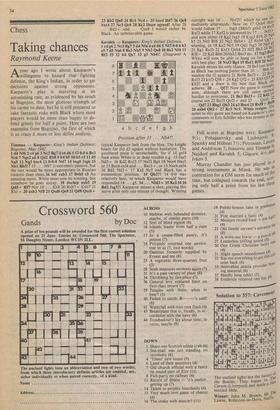Chess
Taking chances
Raymond Keene
Ayear ago I wrote about Kasparov's willingness to hazard that fighting defence, the King's Indian, in order to get
decisions against strong opponents. Kasparov's play is maturing at an astonishing rate, as evidenced by his result at Bugojno, the most glorious triumph of his career to date, but he is still prepared to take fantastic risks with Black where most players would be more than happy to de- fend grimly for half a point. Here are two examples from Bugojno, the first of which is so crazy it more or less defies analysis.
Timmau — Kasparov: King's Indian Defence; Bugojno, May 1982.
1 d4 Nf6 2 c4 g6 3 Nc3 Bg7 4 e4 d6 5 f3 0-0 6 Be3 Nc6 7 Nge2 a6 8 Qd2 Rb8 9 h4 b5 10 h5 e5 11 d5 Na5 12 Ng3 bxc4 13 0-0-0 Nd7 14 hxg6 fxg6 15 Nbl Rb5!? 15 ... Nb7 ;s extremely passive, but the text would be more appropriate in Russian roulette than chess.16 b4! cxb3 17 Bxb5 c5 An amazing move. White must now be winning, but somehow he goes astray. 18 dxc6ep axb5 19 Qd5 + Rf7 Not 19 ... Kh8 20 Rxh7 + Kxh7 21 Rhl + .20 axb3 Nf8 21 Qxd6 Qe8 22 Qd8 Qxc6 + 23 Kb2 Qa8 24 Rcl Nc4+ 25 bxc4 Rd7 26 Qe8 bxc4 27 Nc3 Qc6 28 Ke2 Draw agreed! After 28 Rd2 + and ... Qxe8 I would rather be Black. An unbelievable game.
Kavalek — Kasparov: King's Indian Defence. I c4 g6 2 Nc3 Bg7 3 d4 Nf6 4 e4 d6 5 NB 0-0 6 h3 e5 7 d5 Na6 8 Be3 Nh5 9 Nh2 Qe8 10 Bet Nf4 11 Bf3 f5 12 h4 Qe7 13 g3 Nb4!! (Diagram) A 8 7 6 5 4 3 2
a b cde f gh Position after 13 ... 1V641!
typical Kasparov bolt from the blue. The knight heads for the d3 square without hesitation. The proffered piece is untouchable, for if 14 gxf4 fxe4 when White is in deep trouble e.g. 15 fxe5 Nd3+ 16 Kd2 Rxf3 17 Nxf3 Bg4 18 Nxc4 NxeS or 15 Bxe4 exf4 and . Bxc3 + , or 15 Nxc4 exf4 16 Bd2 Nd3+ l7 Ke2 Ne5 and Black has a tremendous position. 14 Qb3?! 14 0-0 was relatively best, to which Kasparov would have responded 14 ... g5. 14 ... Nfd3 + 15 Ke2 f4 16 Bd2 fxg3?! Kasparov misses a shot, playing this move after only one minute of thought. Winning
outright was 16 ... Nxf2! 1p iN which mediately afterwards. Now on 17 Qxb4 there would follow 17 ... fxg3 18Rhfl gxh2 19 Rxf2 Rxf3 while 17 Kxf2 is answered by 17 . . Nd3+ and now either 18 Kg2 fxg3 19 Kxg3 R 1:4 20 NO h5 21 Ne3 Bf6 22 Ng2 Bxh4+ 23 Rxh4 Q85; winning, or 18 Ke2 Nc5 19 Qdl fxg3 20 N84 16" 21 Rgl Rxf3 22 Kxf3 Qxh4 23 Nf2 Bh3 24 Be3 Rf8 + 25 Ke2 Bh6 26Nxh3 Bxe3 etc. 17 fxg3 Rxf3 White will now be able to hang on for a drat with best play. 18 Nxf3 Bg4 19 Rafl Rf8 20 NO' Kavalek misses his only chance. 20 Be3 just holds
as Black has nothing better than 20 Bh6 (to weaken the f2 square) 21 Bxh6 Bxf3 22 Rxf3
Rxf3 23 kxf3 Qf6 + 24 Kg2 Qf2 + 25 Kh3 QI32 Kh2! and a draw is the best that Black can achieve. 20 ... Qf7! Now the game is virtually won, although there are still some tactical hurdles to overcome. 21 Be3 Bxf3 + 22 Kd2 01, course not 22 Rxf3 Qxf3 + and 23 ... Qxhl. 2k Qd7 23 Rhgl Qh3 24 a3 Bxe4 25 Rxf8 + 13%,fS 26 axh4 Qh2 + 27 Kc3 Ncl. White resigns. The notes to this game are based on Kasparov's ow comments to Eric Schiller who was present at the tournament.
Full scores at Bugojno were: Kascoar°: 91/2; Polugaievsky and Ljubojevic 6; Spassky and Hubner 71/2; Petrosian, Larsen and Andersson 7; Ivanovic and Timman 6; Najdorf and Kavalek 5; Gligoric 4'/r and Ivkov 3.
Murray Chandler has just played in 3 strong tournament at Minsk. He was to contention for a GM norm for much of the time, but collapsed towards the end, scor- ing only half a point from his last three games.






































 Previous page
Previous page